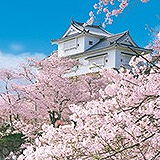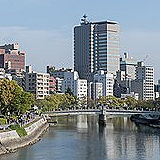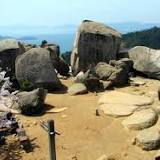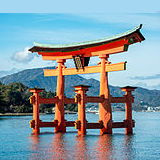
|
Chugoku Last Updated: 07/26/2024 |
| The Chugoku region is one of the eight main regions of Japan, located on the western part of the Honshu island. Chugoku is known for its diverse landscapes, historical sites, and cultural attractions. In 2010, it had a population of 7,563,428. | |
| - Hiroshima: Hiroshima is the largest city in the Chugoku region and is known worldwide for the tragic events of August 6, 1945, when the atomic bomb was dropped on the city during World War II. The Hiroshima Peace Memorial, commonly referred to as the Atomic Bomb Dome, is a UNESCO World Heritage Site that serves as a symbol of peace and a reminder of the horrors of nuclear warfare. - Okayama: Okayama is known for its picturesque landscapes and the beautiful Korakuen Garden, which is one of the "Three Great Gardens of Japan." The city is also home to Okayama Castle, a reconstructed castle with a distinct black exterior. - Shimane: Shimane Prefecture is known for its rich cultural heritage and historical sites. The Izumo Grand Shrine, one of Japan's oldest and most important Shinto shrines, is located in Shimane. The prefecture is also known for its folklore and legends. - Tottori: Tottori is famous for its sand dunes, known as the Tottori Sand Dunes. These expansive dunes attract tourists and provide a unique landscape in Japan. The Tottori Prefectural Museum features exhibits about the region's history, geology, and natural environment. - Cultural Sites: Chugoku is home to a number of historical and cultural attractions, including temples, shrines, and traditional towns. The Akiyoshidai Quasi-National Park in Yamaguchi Prefecture features limestone formations and a large cave system. - Matsue: Matsue is the capital city of Shimane Prefecture and is known for its well-preserved samurai district, Matsue Castle, and the Adachi Museum of Art, which is renowned for its stunning gardens. - Local Cuisine: Chugoku offers a variety of local dishes and culinary specialties. Hiroshima-style okonomiyaki, a savory pancake made with various ingredients, is a notable dish from the region. - Natural Beauty: Chugoku features a mix of landscapes, including mountains, coastline, and rural areas. The region's natural beauty is often celebrated in literature and art. - Onsen - Hot Springs: The region has several hot spring resorts where visitors can relax and enjoy the therapeutic benefits of natural hot springs. Chugoku offers a blend of historical significance, natural beauty, and cultural experiences. It's a region that showcases Japan's diverse landscape and rich heritage. | |
Wikipedia
Japan » Chugoku
Place » City

|
Japan Place » City Japan is an island nation located in East Asia, bordered by the Pacific Ocean on the east and the Sea of Japan on the west. It is known for its rich history, unique culture, beautiful landscapes, and advanced technology. Japan has a population of almost 125 million, of which nearly 122 million are Japanese nationals (2022 estimates). 544 views 💖 1 👍 0Japan |

|
Hiroshima Place » Historical Place Hiroshima, Japan, holds immense historical significance as the first city to suffer an atomic bomb attack during World War II. The devastating event occurred on August 6, 1945, when the United States dropped an atomic bomb named "Little Boy" on the city. The explosion instantly killed tens of thousands of people, and the subsequent radiation exposure led to many more deaths in the following weeks, months, and years. The city had an estimated population of 1,199,391 in 2019. 354 views 💖 1 👍 0Japan |

|
Eshima Ohashi Bridge Place » Outdoors The Eshima Ohashi Bridge, often referred to as the "roller coaster bridge," is a remarkable bridge located in the Chugoku region of Japan, connecting the cities of Matsue and Sakaiminato in Tottori Prefecture. The bridge gained its "roller coaster" nickname due to its steep incline and distinctive appearance. 437 views 💖 3 👍 0Japan |

|
Mount Misen Place » Outdoors Mount Misen is the holy mountain on the holy island Itsukushima in Hatsukaichi, Hiroshima, Japan. At 500 meters above sea level, Mount Misen is the highest peak on Miyajima. On clear days, it affords spectacular views of the Seto Inland Sea and as far as Hiroshima City. There are also a number of Buddhist structures near the peak. 434 views 💖 5 👍 1Hatsukaichi, Japan |

|
Itsukushima Place » Island Itsukushima, also known as Miyajima, is a small island located in the Seto Inland Sea of Japan, near the city of Hiroshima. It is renowned for its iconic Itsukushima Shrine, which is famous for its floating torii gate and its status as a UNESCO World Heritage Site. 552 views 💖 13 👍 0Japan |

|
Atomic Bomb Dome Place » Historical Place The Atomic Bomb Dome, also known as the Hiroshima Peace Memorial, is a symbolic structure located in Hiroshima, Japan. It stands as a powerful reminder of the atomic bombing of Hiroshima during World War II and serves as a memorial to the victims of the bomb and a symbol of the importance of peace and nuclear disarmament. 424 views 💖 5 👍 11-10 Otemachi, Naka Ward, Hiroshima, 730-0051, Japan |
